Copyright 2014 by Elsie M. Campbell All rights reserved. No part of this book may be reproduced in any manner without the express written consent of the publisher, except in the case of brief excerpts in critical reviews or articles. All inquiries should be addressed to Good Books, 307 West 36th Street, 11th Floor, New York, NY 10018. Good Books books may be purchased in bulk at special discounts for sales promotion, corporate gifts, fund-raising, or educational purposes. Special editions can also be created to specifications.
For details, contact the Special Sales Department, Good Books, 307 West 36th Street, 11th Floor, New York, NY 10018 or info@skyhorsepublishing.com. Good Books in an imprint of Skyhorse Publishing, Inc., a Delaware corporation. Visit our website at www.goodbooks.com. 10 9 8 7 6 5 4 3 2 1 Library of Congress Cataloging-in-Publication Data is available on file. Photo credits: front cover; quilts on back cover; title page; by Charles Studio. All other photos by Kenneth L.
Campbell Illustrations and diagrams by Cynthia Vierthaler Design by Cliff Snyder Print ISBN: 978-1-56148-722-6 Ebook ISBN: 978-1-68099-010-2 Printed in the United States of America The diagrams and templates in this book may be reproduced and enlarged for personal or educational use. Excluding diagrams and templates, no part of this book may be reproduced in any manner, except for brief quotations in critical articles or reviews, without permission. The information in this book has been developed with care and accuracy and is presented in good faith. However, no warranty is given nor are results guaranteed. Neither the author nor the publisher has control over the materials or procedures used, and neither has any liability for any loss or damage related to the use of information contained in the book. Should any corrections be needed, they will be posted at .
Cataloging-in-Publication data available from the Good Books website. Introduction The first quilt block that my mother taught me to make was a Four-Patchjust four small squares of fabric, two light and two dark, stitched together to form a block. I was pre-school at the time. Mother entertained my younger sister, Linda, and me by teaching us to use a pencil to trace around a cardboard square cut from an empty Cornflakes box onto scraps of fabric. She showed us how to place the cardboard square next to the first square we traced, so as not to waste fabric. Then we learned to use scissors to cut exactly on the lines we had drawn.
My father added an electric motor to a treadle sewing machine to make it easier and quicker for Mother to sew. When Linda and I wanted to play at sewing, Mother would disengage the electric motor and replace the treadles leather drive strap so that the machine was ready for treadle use, and we were allowed to sew. However, our little legs were not long enough to operate the treadle properly. We soon discovered that one of us could turn the sewing machines drive wheel while the other put the fabric pieces under the needle to stitch them together. We took turns operating the machine and sewing. Of course, we were soon bored with this, but we managed to stitch a bunch of Four-Patch blocks together over a period of time.
Years later, Mother discovered all those long-forgotten Four-Patch blocks in a closet. By adding framing strips and large alternate squares, she turned those pieces into two queen-sized quilts for our Christmas gifts. My husband and I still sleep under my quilt in the winter. It is a little like getting a warm hug from Mom with all the memories stitched into that quilt. There are a few pieces from my favorite sailor dress. There are bits from the little summer tops we wore and fabric left from the matching pinafores and blouses that Mom made for us.
Even scraps of Daddys pajamas are in that quilt. Making quilts has been an important part of my life for a very long time. I have learned to make intricate, precision-pieced, and appliqued works of art that have won multiple awards in national competitions. But after spending many years perfecting my craft, I have come to understand that traditional, easy-to-stitch blocks, like Nine-Patch and half-square triangle units, are very versatile. Though straightforward and simple, these blocks present many design possibilities. Using two or more of these blocks in combination exponentially increases the number of design options from which one can choose.
I like to think of these many variations as Sister Quilts, an idea which came from my mother. She had three daughters, each unique in appearance and personality. Although my sisters and I do not look much alike, she would say, But you are cut from the same cloth. Even though we dont appear to be closely related, we share common DNA. So it is with the diverse quilts patterned in this book.  To begin, these simple units can be combined in two ways: the Four-Patch and Nine-Patch.
To begin, these simple units can be combined in two ways: the Four-Patch and Nine-Patch.  To begin, these simple units can be combined in two ways: the Four-Patch and Nine-Patch.
To begin, these simple units can be combined in two ways: the Four-Patch and Nine-Patch.
Take, for example, the traditional block, Corn and Beans.  This block may be constructed from 2 large triangles, one light and one dark, plus several smaller triangles. However, this construction technique would require stitching pieces together along bias edges, and this can create problems. The fabric pieces can stretch when theyre handled or stitched because the threads of the cloth do not run parallel with the cut edge. A Better Approach As I examined this block more closely, I found a better way to construct it. I thought of it as a Nine-Patch block that could be stitched together from squares and from half-square triangle units.
This block may be constructed from 2 large triangles, one light and one dark, plus several smaller triangles. However, this construction technique would require stitching pieces together along bias edges, and this can create problems. The fabric pieces can stretch when theyre handled or stitched because the threads of the cloth do not run parallel with the cut edge. A Better Approach As I examined this block more closely, I found a better way to construct it. I thought of it as a Nine-Patch block that could be stitched together from squares and from half-square triangle units.
By using one of the three methods described in the following pages for quick construction of half-square triangle units (pages 12-15), you can avoid having to stitch along a bias edge when making this block. You will find that I suggest putting other traditional blocks, used to make the quilt patterns in this book, together in the same way. The large blocks are formed from combinations of squares and half-square triangle units, which are easy to handle and stitch.  Even though Four-Patch and Nine-Patch quilt blocks are simple to sew, the result of combining them in a single quilt can be quite sophisticated. Enjoy exploring the possibilities hidden in Squares and Triangles! Tips for Making Squares and Triangles Quilts TIP #1 Cut perfect squares Tools Efficient cutting techniques make a boring and sometimes tedious task quick and easy. You probably already own everything youll need to cut these simple pieces if youve been quilting for a while.
Even though Four-Patch and Nine-Patch quilt blocks are simple to sew, the result of combining them in a single quilt can be quite sophisticated. Enjoy exploring the possibilities hidden in Squares and Triangles! Tips for Making Squares and Triangles Quilts TIP #1 Cut perfect squares Tools Efficient cutting techniques make a boring and sometimes tedious task quick and easy. You probably already own everything youll need to cut these simple pieces if youve been quilting for a while.
If not, these tools are worth buying. Two or more rotary cutting rulers . A 6 12 rectangle and a 6 square are the first rulers you should have in your collection. The lines should be easily visible on all fabrics. I especially like the rulers with black lines and non-slip grips on their undersides made by Creative Grids. Others you may find useful are the Setting Triangle ruler by Little Foot and a 6 24 rectangle ruler.
A good rotary cutter. A 45mm cutter is the best size for most rotary-cutting purposes. Look for one with a non-slip grip and with a blade that retracts easily or automatically when not in use. As you progress in your quiltmaking skills, consider adding a 25 mm cutter for cutting small detailed pieces and a 60 mm cutter for cutting layers of fabric at one time. I have several favorites. The Martelli ergonomically correct cutter works best for me when I am cutting from a sitting position.

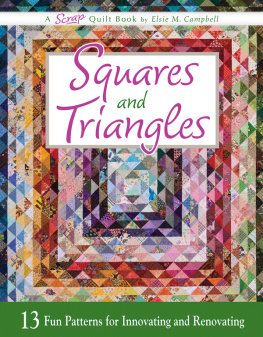
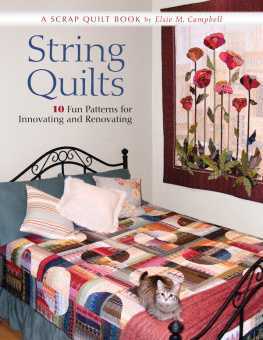

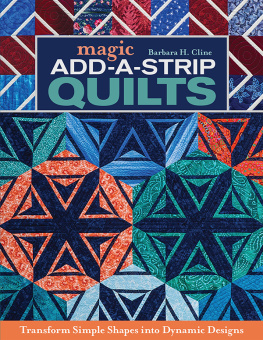
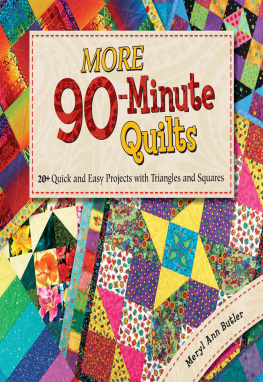
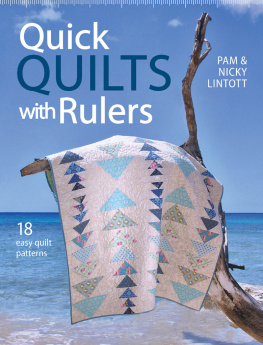

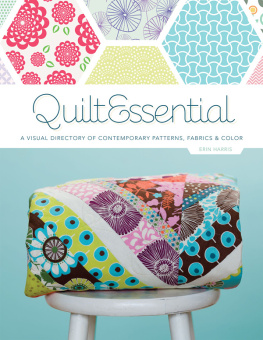
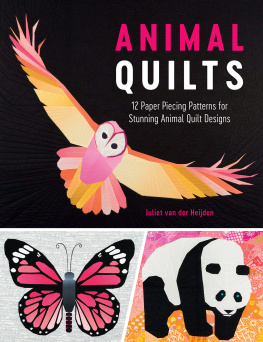
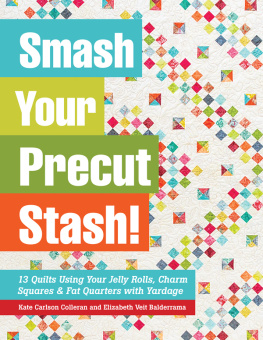
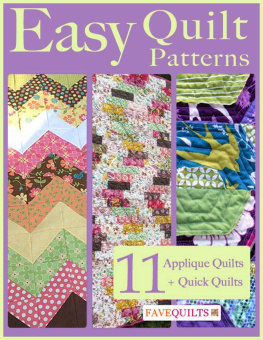
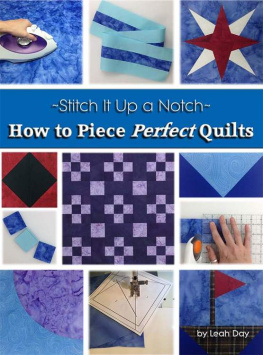

 To begin, these simple units can be combined in two ways: the Four-Patch and Nine-Patch.
To begin, these simple units can be combined in two ways: the Four-Patch and Nine-Patch.  This block may be constructed from 2 large triangles, one light and one dark, plus several smaller triangles. However, this construction technique would require stitching pieces together along bias edges, and this can create problems. The fabric pieces can stretch when theyre handled or stitched because the threads of the cloth do not run parallel with the cut edge. A Better Approach As I examined this block more closely, I found a better way to construct it. I thought of it as a Nine-Patch block that could be stitched together from squares and from half-square triangle units.
This block may be constructed from 2 large triangles, one light and one dark, plus several smaller triangles. However, this construction technique would require stitching pieces together along bias edges, and this can create problems. The fabric pieces can stretch when theyre handled or stitched because the threads of the cloth do not run parallel with the cut edge. A Better Approach As I examined this block more closely, I found a better way to construct it. I thought of it as a Nine-Patch block that could be stitched together from squares and from half-square triangle units. Even though Four-Patch and Nine-Patch quilt blocks are simple to sew, the result of combining them in a single quilt can be quite sophisticated. Enjoy exploring the possibilities hidden in Squares and Triangles! Tips for Making Squares and Triangles Quilts TIP #1 Cut perfect squares Tools Efficient cutting techniques make a boring and sometimes tedious task quick and easy. You probably already own everything youll need to cut these simple pieces if youve been quilting for a while.
Even though Four-Patch and Nine-Patch quilt blocks are simple to sew, the result of combining them in a single quilt can be quite sophisticated. Enjoy exploring the possibilities hidden in Squares and Triangles! Tips for Making Squares and Triangles Quilts TIP #1 Cut perfect squares Tools Efficient cutting techniques make a boring and sometimes tedious task quick and easy. You probably already own everything youll need to cut these simple pieces if youve been quilting for a while.